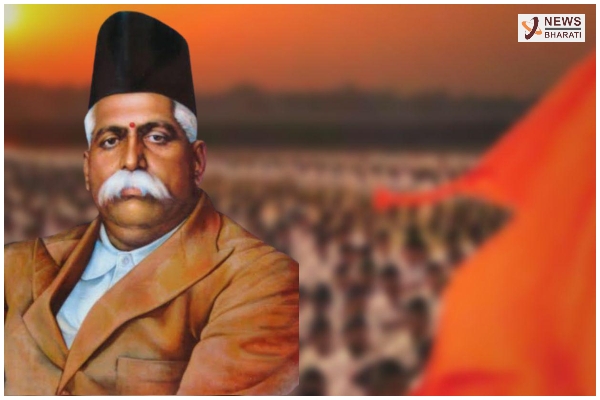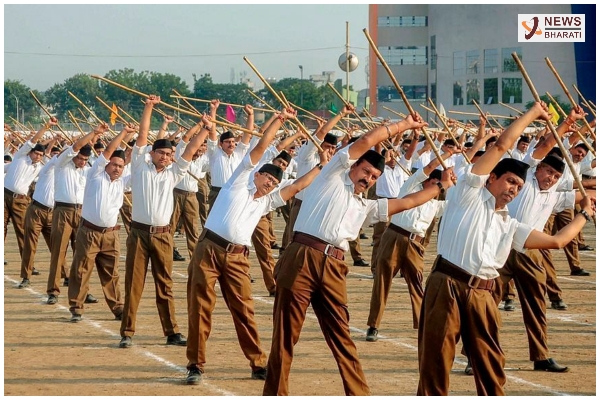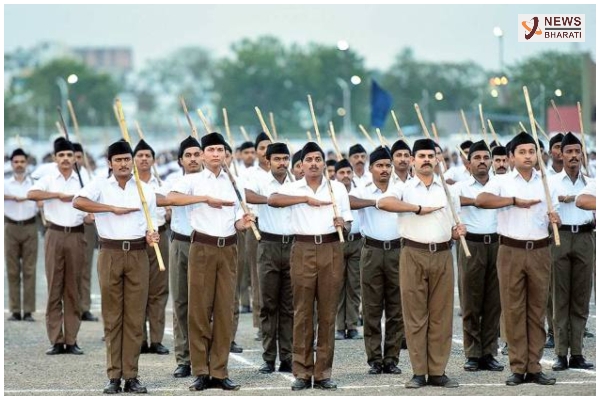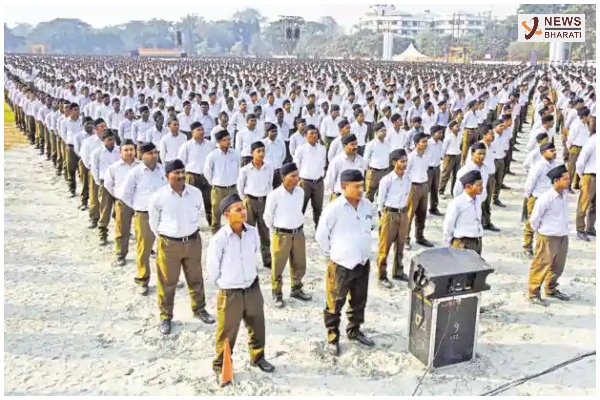The RSS’ Shakha Model: A unique gift of Dr. Hedgewar to society
Total Views |
The Rashtriya Swayamsevak Sangh or simply RSS, as it is popularly known globally, has grown into a huge Banyan tree with over 60,000 shakhas and lakhs of swayamsevaks engaged in various types of activities beneficial to the society in very many ways. Founded in 1925 on the auspicious Vijayadashami Day by Dr. Keshav Baliram Hedgewar, a medical graduate of the early 20s and a born patriot, the RSS today, after traversing a journey of 95 years, has attracted the attention of scholars worldwide. There are scholars who are doing their doctoral research on the RSS in countries like the USA. But, here in India, the RSS is looked upon as a ‘secret’ organization, shrouded in the cobweb of mysteries leading to wrong concepts, misleading and mischievous propaganda and misunderstanding. The main misunderstanding seems to be about the working model and style of the RSS.
Those who look at the RSS from a distance believe that the RSS works in a ‘secret’ manner. They allege that there is no internal democracy in the RSS because they are working on the principle of “Ekchalakanuvartittva”, i.e. following the orders of one single individual. Therefore, they easily draw the inference that the RSS follows dictatorship and compare it with the ‘Nazi’ force of Germany’s dictator Adolf Hitler. Some of them even go to extend of presenting RSS as ‘Anti-Muslims’ and ‘Anti-Christians’ as the Sangh confines itself to organizing the Hindus only.

Leaders like Rahul Gandhi also dub RSS as ‘Anti-women’, ‘anti-tribal’ and ‘anti-Dalits’. These allegations are being leveled against the RSS more vigorously since the BJP government has come to power at the national and state levels with thumping majority since 2014. Criticism apart, what exactly the working system of the Sangh? Have these critics of the RSS ever tried to study, understand and analyze the working model of the RSS that has evolved throughout this long and hazardous journey of the organization? No. They did not. Because they do not have the intellect to do so as their vision does not see beyond the electoral politics. In the pursuit of their political mission, RSS for them is a ‘popular whipping boy’ to arouse sentiments and to spread phobia among the non-Hindus, especially the Muslims, who constitute a massive vote bank for their political game plan. However, the common masses, who are becoming familiar, though slowly, with the work of the RSS, must study this model of the RSS which has created giants from among the common people. This is the best human resources development model RSS Founder Dr. Keshav Baliram Hedgewar gifted to the society 95 years ago which is still evolving as per the needs and the changing social scenario.
The foundation of RSS:
The RSS was founded in 1925 at Nagpur in Central India on the Vijayadashami Day. The aim was to organize the Hindu society to take Bharat to the highest place in the world order and to create and acquire necessary capability to lead the world. In those days, the country was under the occupation of the British Government and therefore, the first and foremost mission of the Sangh was to liberate Mother Bharat. Before, founding the RSS, Dr. Hedgewar, a born patriot as he was was associated with the revolutionary organization called ‘Anusheelan Samiti’ while he went to pursue his medical education at the National Medical College at Kolkata. He actively participated in many movements then associated with the freedom struggle and was closely following leaders like Lokmanya Tilak, Babu Aurobindo Ghosh, M K Gandhi, and so on. He used to lead from the front agitations and movements launched by the Congress under Gandhi’s leadership. In fact, he was the provincial secretary of the Congress party then! He actively participated in the non-cooperation movement of the 1920s and the ‘Jungle Satyagraha’ of 1930s and suffered the jail terms also.
But after a deep thought and analysis of the state of Hindu society, Dr. Hedgewar concluded that Bharat is essentially a ‘Hindu Rashtra’ and the Hindu society is its backbone. The pathetic situation of the country today was due to unorganized nature of the Hindu society. Therefore, if the issues confronting the nation are to be resolved, then the first condition is to create an organized, consolidated Hindu society. Even the if the country is freed but the society remained unorganized, there will be another instance of slavery the country will suffer. Hence, he decided his life mission to organize the Hindu society.
Work system:
It is quite natural for any organization to have its own working system; a model to conduct its activities and, to prepare its workforce to reach its target. Different organizations adopt various types of techniques. Dr. Hedgewar instead of accepting and adopting the available techniques decided to introduce his own unique technique for the RSS. He was of the view that a total revolution in the mental attitude of the Hindu society was of utmost importance and this mission of molding the minds of and building character cannot be accomplished by giving sermons and administering pledges.
So, when he founded the RSS he simply told his colleagues “We are starting our Sangh today”. The name ‘Rashtriya Swayamsevak Sangh’ was not fixed then. It took almost a year to decide upon the name of this organization. At a meeting held on 17th April 1926, three names were suggested including the present one, and after detail consideration of the pros and cons, they were put to vote and the highest polled name “Rashtriya Swayamsevak Sangh” was adopted.

The same policy was adopted for the development of working model. In the early days the ‘RSS Members’ (Sangh Sabhasad) used to go to some ‘Vyayamshala’ (equivalent to present-day gyms) and were expected to do sufficient physical exercises. But it was mandatory for them to assemble at 5 am on every Sunday at the ‘Itwar Darwaja Primary School’ ground. Here, they were taught drill and other physical exercises by Martandrao Jog.
Thus, this was the beginning of the daily ‘shakha’ of the RSS which later on evolved as strong bedrock of the present multi-dimensional expanse of the Sangh. This daily Shakha, as noted by N H Palkar in his book, was started in May 1926 at the famous “Mohite Wada” ground in Mahal, Nagpur, where the present RSS HQ is located. During this time, the ‘Political Classes’ (राजकीय वर्ग) were also launched to acquaint the swayamsevaks with the socio-political realities. These classes were held every Thursday. Later on after 1927, these ‘Political Classes’ were re-christened as ‘Bouddhik Varg’ in the RSS Parlance.
The ‘Mantra’ and the ‘Tantra’:
Dr. Hedgewar was not the only visionary to have batted for Hindu consolidation for the regeneration of Hindu Rashtra. Swami Vivekananda, Swami Ramateerth, Swami Dayanand, Babu Aurobindo Ghosh, Lokmanya Tilak, Lala Lajpat Rai, Pandit Madan Mohan Malviya, V D Sawarkar etc. have forcefully and consistently argued in favor of Hindu consolidation. The mental make-up of the Hindu society was so low and perverted that they used to say; “call us donkey, horse, etc. but don’t call us Hindu”. Some of these would even equate organizing Hindus with weighing frogs! Dr. Hedgewar accepted this challenge to rescue the Hindu society from this low state and awaken nationalism and patriotism among them. Dr. Hedgewar gave a simple ‘Mantra’ of Hindu consolidation and gifted the easy ‘Tantra’ of daily ‘shakha’ for its accomplishment.
The identity of RSS is because of this ‘Shakha’. The Shakha is the public face of the RSS. This is a novel expression of Dr. Hedgewar’s organizing skill. After deeply analyzing the multi-dimensional nature of human mind he launched this technique. Nowhere in the world is there any parallel to this unique technique found to exist. The late Sri M S Golwalkar ‘Guruji’ who succeeded Dr. Hedgewar as Sarsanghchalak used to say about this ‘Shakha’ model: “The Shakha is a living practice of principles and not a bundle of dry preaching. The picture of earnest and devoted men, young and old, engaged in daily ‘Sadhana’ gives an eloquent though silent, message of the work which no spoken or written word can even adequately convey.
Regularly coming together, playing together, and discussing issues together with no prejudices help increase mutual love, bonding and fraternity. This may be a surprise for the world but for us it is the most important aspect of our work, says Sri Guruji. Noted thinker and founder of the Bharatiya Mazdoor Sangh (BMS) and many other organizations, Late Dattopant Thengdi has this to say about the technique of ‘Shakha’ and its utility: “In the absence of the such a feeling of mutual love, affection it would be next to impossible to raise any organization in any sphere of our national and social life. For such an affinity, it is imperative for people to gather at a place daily because, to meet is to know; to know is to understand; and to understand is to love. That’s why stress is given to attend daily ‘Shakha’.

According to Sri Guruji there are three principles that guide the model of daily ‘Shakha’-
1. The original thought of fraternity
2. Trust – Will be built by coming together daily
3. Actual work – Attending the shakha regularly.
What is shakha? There is an open playground where under the Saffron Flag, groups of boys, youths and elderly persons are engaged in various activities. They all assemble at the leader’s whistle. Do Suryanamaskars and other yogasanas; sing a patriotic song, listen to the views on various subjects or a story from the history and finally end with a prayer “नमस्ते सदा वत्सले मातृभूमे’ in front of the Saffrron Flag which is accepted as ‘Guru’ (Ideal) by the RSS. Such a scene is visible all over the country, in towns and cities, in villages and hamlets, in remote areas and mountains and valleys. At present, the number of such ‘Shakhas’ of RSS has crossed 60,000 and will be crossing the 100,000 figure by the time it celebrates its centenary.
Apart from the daily shakha the RSS also has evolved a model of ‘Weekly Shakhas’ (साप्ताहिक मिलन) and ‘Sangh Mandali’ (संघ मंडली) to reach out to the people for whom attending daily shakha is difficult for various compulsions. With this vast network of Shakhas the RSS has reached to almost 95 percent of the country’s geographical area besides its swayamsevaks running over 150000 service projects in various fields of our social life.
The objective:
What can be achieved through this ‘Shakha Model’? Dr. Hedgewar explained that the basic objective is to awaken ‘Rashtra Nishtha’ (allegiance to the nation) in place of ‘Vyakti Nishtha’ (allegiance to an individual) in the masses and for this, all should assemble regularly at the ‘Sanghsthan’ (the place of shakha) and conduct various programs in the presence of Saffron Flag with discipline and devotion.
The RSS Shakha is the centre of activities of its surrounding area. Former RSS Sarsanghchalak the late Balasaheb Devras who succeeded Sri Guruji says this about the Sangh Shakha:

“The RSS Shakha is not just a place to play games or parade, but an unsaid promise of the protection of the good citizenry; and acculturation forum to keep the young away from undesirable addictions; it is a centre of hope for rapid action and undemanding help in case of emergencies, and crisis that affect the people. It is a guaranty of the unafraid movement of women and a powerful deterrent to the indecent behavior towards them; also a powerful threat to the brutal and anti-national forces. But the most important aspect is it is a university for training the appropriate workers to be made available for the requirements of the various fields of the life of the nation. And, the medium to achieve this is the games we play on the grounds of RSS Shakha.”
Only Balasaheb Devras had the capability and analyzing mind to so correctly decipher the deep inherent purpose and purport of this ‘Shakha’ technique introduced by RSS Founder Dr. Hedgewar. Dr. Hedgewar did not want RSS to be another organized force within the society. He visualized that entire Hindu society as a united and organized one and Shakha was a tool to achieve this objective. As Dr. Sanjeev Kelkar says, this was an ingenious contribution of Dr. Hedgewar.
Events to connect with history: Dr. Hedgewar’s genius lies in the fact that he introduced some prominent Hindu elements like ‘Gurupujan’ and ‘Guru Daxina’, Hindu Samrajya Dinotsava as Coronation Day of Chhatrapati Shivaji Maharaj, Vijayadashami as RSS Foundation Day, Varshpratipada, Rakshabandhan, and Makar Sankranti as he believed that these events would connect the Hindu society into one organized force. It was the form and selected at that time to develop a positive outlook towards the country’s history and feel proud about it.
The farsighted vision of Dr. Hedgewar was to produce men with honest character and credibility who would make every effort to undertake right actions in the various spheres of national life after independence. He diagnosed the ills that plagued the society as lack of right kind of people with impeccable integrity who would come up with the solutions to these problems. This diagnosis is still valid as it was 95 years ago when the RSS was launched. It was not that the RSS was the first to start these ‘utsavs’ in the Hindu society. They were being celebrated by the society since the hoary past. But the difference lies in RSS giving an extensive social and national dimension to these ‘utsavs’ in accordance with the inspiration and working model of the organization.
RSS as a Power House: Dr. Hedgewar used to say that the Sangh is a power house from where energy in the form of well molded nationalist men with unblemished and sterling character will go out in the various spheres of national life, influence them and set them right. He would insist that he needed 3 percent of swayamsevaks in the urban and 1 percent in the rural areas that would provide the masses with necessary leadership. Noted writer and historian Arnold Toynbee also said recognizing the need for such people in a culture and put their number at 10 percent who can offer leadership to remaining 90 percent of the people.
And Shakha is the model that would continuously supply this energy by molding men through the various programs conducted on an open ground under the benign presence of the Saffron Flag. H V Seshadri, former Sarkaryawah of RSS says that the technique of Sangh called the Shakha that Dr. Hedgewar evolved was designed to creae an intense, unified national consciousness among our people. Shakha is a place where the real spirit of the Sangh can be understood, says Sri Guruji. We used to sing a Marathi song during our childhood days in the Shakha. It goes like this –
सांगता तुम्ही संघ मोठा संघात हाय काय || संघात आल्या बिगर उमजायचं नाय नाय ||
(You say, Sangh is great, what is there in Sangh? You will understand it only after coming to Sangh that is shakha), can be the rough translation of this song.
Time tested technique: Soon after the 1975 Emergency, some Congress leaders including Sanjay Gandhi decided to copy the RSS technique for their cadres. Balasaheb Devras was in Delhi then. Some RSS swayamsevaks showed him the news in this regard and sought his opinion. Balasaheb told them not to worry because the Congress people would not be successful as they lacked sustainability, seriousness, perseverance and consistency to carry out such an exercise. And he was correct. The Congress plan did not come up at all!
The Sangh has evolved this present technique of Shakha on the time-honored pattern of imparting samskars. This process of imparting daily samskars, Sri Guruji says, is carried out in consonance with the ideals of national reorganization, inspired by ‘Nation First’ concept in the daily Shakhas. Inspired with the spirit of devotion to Nation God the various apparently small things like games, singing songs, doing Suryanamaskaras and Yogasanas, and physical drills, acquire the potency of instilling deep samskara for an organized and powerful national life.
Following the first ban on RSS in 1948, some senior swayamsevaks pleaded for rethinking on the utility of the Shakha model and approached Sri Guruji to know his thoughts. Sri Guruji said, “There is no work matching that of RSS in the entire world. This is our original thought and not a copy of others. Once you are completely aware of the totally independent talent you will never get tired of our work”. And he proved prophetically right for the work model adopted, developed and implemented by the RSS for organizing the society and engage it in the mission of national reorganization is self-contained, and unique. There is no alternative to this model because this has withstood the tests of the time.
Ref:-
1. Golwalkar, M S: Bunch of Thoughts, 7th Edition, April 2017, Sahitya Sindhu Prakashana, Bengaluru.
2. Seshadri H V: RSS A Vision in Action, 2nd Edition, April 2000, Sahitya Sindhu Prakashana, Bengaluru
3. Sharda, Ratan: RSS 360 Degrees: Demystifying Rashtriya Swayamsevak Sangh, 2018, Bloomsbury India, New Delhi.
4. Kelkar Sanjeev: Lost Years of the RSS, 2011, Sage Publications India Ltd., New Delhi.
.
.
